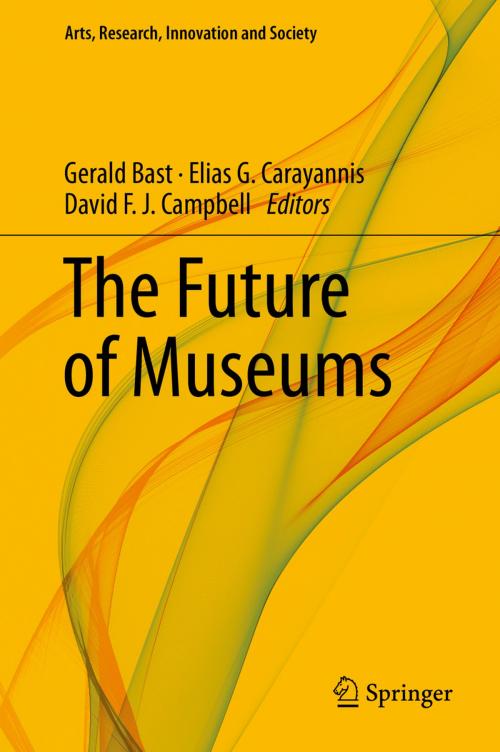The Future of Museums
Business & Finance, Management & Leadership, Production & Operations Management, Nonfiction, Social & Cultural Studies, Social Science, Anthropology| Author: | ISBN: | 9783319939551 | |
| Publisher: | Springer International Publishing | Publication: | October 1, 2018 |
| Imprint: | Springer | Language: | English |
| Author: | |
| ISBN: | 9783319939551 |
| Publisher: | Springer International Publishing |
| Publication: | October 1, 2018 |
| Imprint: | Springer |
| Language: | English |
This book explores―at the macro, meso and micro levels and in terms of qualitative as well as quantitative studies―the current and future role of museums for art and society. Given the dynamic developments in art and society, museums need to change in order to remain (and in some ways, regain) relevance. This relevance is in the sense of a power to influence. Additionally museums have challenges that arise in the production of art through the use of permanent and rapidly changing technologies. This book examines how museums deal with the increasing importance of performance art and social interactive art, artistic disciplines which refuse to use classical or digital artistic media in their artistic processes. The book also observes how museums are adapting in the digital age. It addresses such questions as, “How to keep museums in contact with recipients of art in a world in which the patterns of communication and perception have changed dramatically,” and also “Can the art museum, as a real place, be a counterpart in a virtualized and digitalized society or will museums need to virtualize and even globalize themselves virtually?” Chapters also cover topics such as the merits of digital technologies in museums and how visitors perceive these changes and innovations.
When you go back to the etymological origin, the Mouseion of Alexandria, it was a place where – supported by the knowledge stored there – art and science were developed: a place of interdisciplinary research and networking, as you would call it today. The word from the Ancient Hellenic language for museum (ΜΟΥΣΕΙΟΝ) means the “house of the muses”: where the arts and sciences find their berth and cradle. With the “Wunderkammer,” the museum was re-invented as a place for amazing for purpose of representation of dynastic power, followed by the establishment of museums as a demonstration of bourgeois self-consciousness. In the twentieth century, the ideal of the museum as an institution for education received a strong boost, before the museum as a tourism infrastructure became more and more the institutional, economic and political role-model. This book is interested in discovering what is next for museums and how these developments will affect art and society. Each of the chapters are written by academics in the field, but also by curators and directors of major museums and art institutions.
This book explores―at the macro, meso and micro levels and in terms of qualitative as well as quantitative studies―the current and future role of museums for art and society. Given the dynamic developments in art and society, museums need to change in order to remain (and in some ways, regain) relevance. This relevance is in the sense of a power to influence. Additionally museums have challenges that arise in the production of art through the use of permanent and rapidly changing technologies. This book examines how museums deal with the increasing importance of performance art and social interactive art, artistic disciplines which refuse to use classical or digital artistic media in their artistic processes. The book also observes how museums are adapting in the digital age. It addresses such questions as, “How to keep museums in contact with recipients of art in a world in which the patterns of communication and perception have changed dramatically,” and also “Can the art museum, as a real place, be a counterpart in a virtualized and digitalized society or will museums need to virtualize and even globalize themselves virtually?” Chapters also cover topics such as the merits of digital technologies in museums and how visitors perceive these changes and innovations.
When you go back to the etymological origin, the Mouseion of Alexandria, it was a place where – supported by the knowledge stored there – art and science were developed: a place of interdisciplinary research and networking, as you would call it today. The word from the Ancient Hellenic language for museum (ΜΟΥΣΕΙΟΝ) means the “house of the muses”: where the arts and sciences find their berth and cradle. With the “Wunderkammer,” the museum was re-invented as a place for amazing for purpose of representation of dynastic power, followed by the establishment of museums as a demonstration of bourgeois self-consciousness. In the twentieth century, the ideal of the museum as an institution for education received a strong boost, before the museum as a tourism infrastructure became more and more the institutional, economic and political role-model. This book is interested in discovering what is next for museums and how these developments will affect art and society. Each of the chapters are written by academics in the field, but also by curators and directors of major museums and art institutions.















